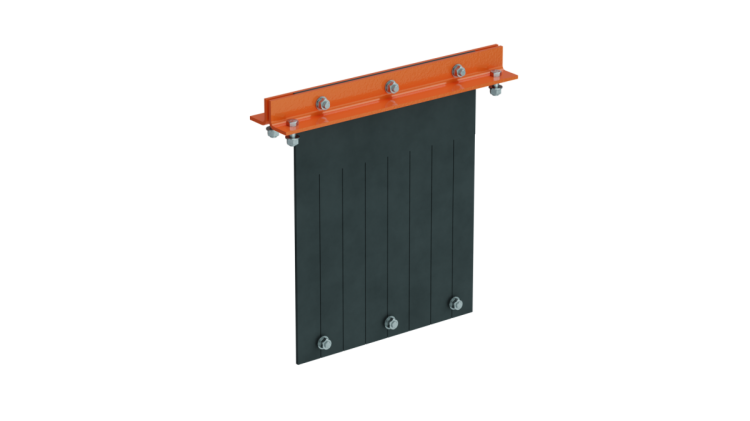Dust Curtain
Installed near end of transfer point chute enclosure, Martin® Dust Curtains slow loading zone airflow so airborne dust settles back into belt cargo.
Features and Benefits:
- Recommended installation is one dust curtain without slits closest to loading zone, followed by one dust curtain with slits at exit of skirtboard. Additional dust curtains may be installed to reduce air movement and isolate dust suppression or dust collection systems for additional dust control
- Curtains form a plenum that slows air velocity, allowing airborne particles to return to belt
- Slit curtains conform to belt load without pushing material off conveyor
- Curtains hang to 1 inch (25 mm) below normal material profile on belt
- Curtain bolts into steel frame for simple replacement
- Rugged 1/4-inch (6 mm) rubber construction provides extended service in tough conditions
Our technicians and engineers are available to provide expert advice and assistance on this product and all of your bulk material handling questions and problems. Please contact us today and let us help!
We Solved Their Problems!
Let us help you solve yours as well. All products and services provided by Martin Engineering carry our Absolutely No Excuses Guarantee. If we don't solve your problem, we will fully refund your money or provide a different solution for you. Period.
Martin Transfer Point Products Reduce Risk Of Fire Or Explosion
This power plant had dust and spillage escaping from the coal-handling systems. To boost material-handling efficiency and reduce the risk of fire or explosion, Martin installed taller and longer skirtboard walls, new belt support systems, abrasion-resistant wear liners, and a multi-layer, low-pressure sealing system on the outside of the chute walls.
Installing Dust Containment Solutions at Sugar Processing Plant
A sugar processing plant in California handles approximately 10,000,000 tons of raw sugar per year through their plant. One of the transfer points was giving them trouble with spillage. They contacted Martin distributor Applied Conveyor Technology (ACT) for their recommendation. ACT recommended upgrading the transfer point with cradles, wearliner, dust curtain and skirting.
Dust Curtain Keeps Fugitive Material From Nearby Homes And Businesses
A Minnesota power generating facility was having trouble controlling dust and spillage and preventing fugitive material from reaching nearby homes and businesses. With variable size and moisture content of the fuel, chips would fall back down. Reducing material turbulence during transfer is essential to prevent fugitive dust.
Transfer Point Products Improve Severe Spillage And Dust Problems
At a cement plant in Kentucky, the clinker transport system had severe problems with the escape of spillage and airborne dust in the loading zones of three conveyors. Martin® Transfer Point Solutions were recommended to stop the spillage and dust problems. To improve the clinker conveying, the plant agreed to upgrade the transfer points.
Power Plant Needs Cleaner, Safer, More Productive Material Handling System
The Warrick Power Plant is operated by the Alcoa Generating Company to supply electricity for smelting operations at Alcoa’s Warrick facility. The plant’s coal handling equipment needed reconstruction and improvement, including improved systems to control spillage and dust, to provide a cleaner, safer and more productive coal handling system.
Transfer Point Solutions Resolve Carryback At Kentucky Energy Plant
An energy company in Kentucky was having problems with carryback on their side-by-side transfer belts carrying coal from the central reclaim tunnel to the bunkers. They hired Martin Engineering to find a solution. Martin recommended a variety of belt support, belt sealing, tail protection and dust containment solutions as well as safety accessories.
